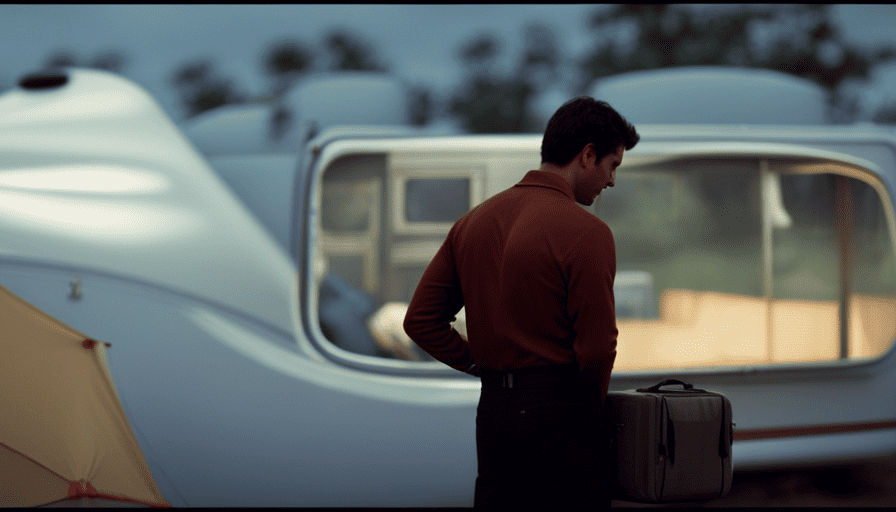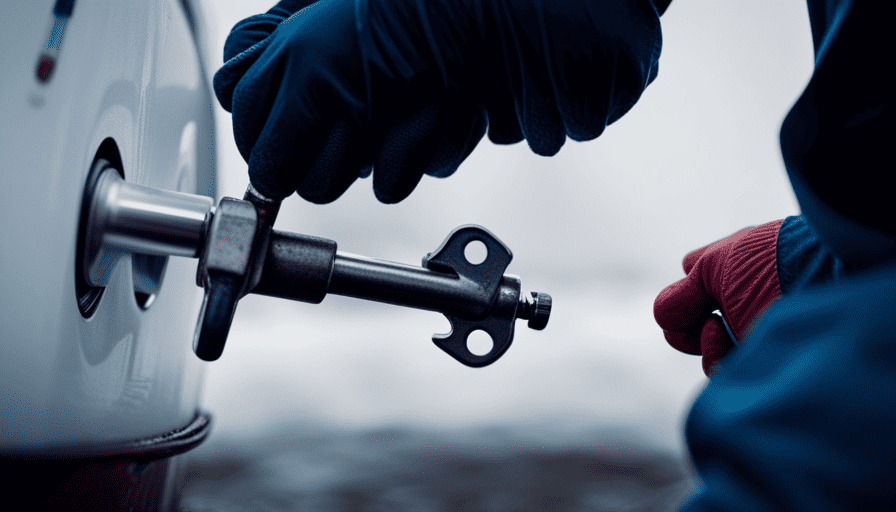Did you know that the average person produces around 2 to 4 pints of water vapor every day through activities like breathing, cooking, and showering? Now, imagine yourself in a confined space like a camper, where all this moisture has nowhere to escape. What happens next? Condensation.
It’s a common problem for camper owners, but fear not, because in this article, I’m going to share some practical tips on how to keep condensation out of your camper.
First, it’s important to understand the causes of condensation. Factors like poor insulation, lack of ventilation, and high humidity levels can all contribute to this pesky issue. To combat condensation, you’ll need to insulate your camper, improve ventilation, and manage humidity levels. Additionally, using dehumidifiers or moisture absorbers, as well as insulated window coverings, can help reduce moisture buildup.
Regularly checking for leaks and repairing them, as well as maintaining proper air circulation, are also crucial steps in preventing condensation. By following these tips, you can enjoy a dry and comfortable camping experience, free from the annoyance of condensation.
Key Takeaways
- Insulate camper and improve ventilation to combat condensation
- Use portable dehumidifiers, silica gel packets, or DampRid to reduce moisture
- Properly ventilate camper by opening windows, using vents, or installing ventilation fans
- Use breathable fabrics, insulated window coverings, and sealants to prevent condensation and maintain temperature
Understand the Causes of Condensation in Campers
To keep condensation out of your camper, you need to understand why it forms in the first place. Condensation occurs when warm air inside the camper comes into contact with cold surfaces, causing the moisture in the air to turn into water droplets. This can happen due to a variety of reasons, such as cooking, showering, or even just breathing.
Additionally, poor ventilation can exacerbate the problem by trapping the moist air inside the camper.
To prevent condensation in your camper, there are a few practical tips you can follow. Firstly, make sure to properly ventilate your camper by opening windows or using vents. This allows the moist air to escape and fresh air to circulate, reducing the chances of condensation forming. You can also use dehumidifiers or moisture-absorbing products to help control the humidity levels inside.
Another important step is to insulate your camper. By adding insulation to the walls, floors, and ceiling, you can create a barrier that prevents the warm air inside from coming into contact with the cold surfaces outside. This not only helps to reduce condensation but also improves the overall thermal efficiency of your camper.
Understanding the causes of condensation and implementing prevention tips is crucial in keeping your camper free from moisture-related issues. Insulating your camper is the next step in creating a comfortable and condensation-free environment.
Insulate Your Camper
One way to make your camper more enjoyable is by insulating it to keep the temperature comfortable. Insulating your camper not only helps in maintaining a pleasant temperature inside but also prevents condensation buildup. Here are four energy-efficient insulation options that can be used for your camper:
-
Spray foam insulation: This type of insulation is known for its ability to seal gaps and cracks, ensuring that no air leaks occur. It provides excellent thermal resistance and helps in reducing energy loss.
-
Reflective insulation: This insulation option is made up of a reflective material that reflects heat away from your camper. It’s easy to install and can be placed in walls, ceilings, and floors to keep your camper cool in hot weather.
-
Fiberglass insulation: Fiberglass insulation is a popular choice due to its affordability and effectiveness. It’s easy to install and provides excellent thermal insulation, keeping your camper warm in cold weather.
-
Foam board insulation: Foam board insulation is lightweight and provides great thermal resistance. It can be easily cut and installed in walls, floors, and ceilings to maintain a comfortable temperature inside your camper.
Insulating your camper has several benefits. It helps in reducing energy consumption by keeping the temperature stable, which in turn saves money on heating or cooling. Additionally, insulating your camper also reduces the risk of condensation buildup, preventing damage to your camper’s interior.
To further combat condensation, the next step is to use dehumidifiers or moisture absorbers.
Use Dehumidifiers or Moisture Absorbers
I’ve found that using portable dehumidifiers, silica gel packets, or DampRid can be incredibly helpful in reducing moisture and preventing condensation in my camper.
Portable dehumidifiers are easy to use and can be placed in areas where moisture tends to accumulate the most.
Silica gel packets and DampRid are great options for smaller spaces or areas that are harder to reach, as they can be placed in cabinets, closets, or under furniture to absorb excess moisture.
Portable Dehumidifiers
Prevent condensation in your camper by using portable dehumidifiers to keep the air dry and comfortable. Portable dehumidifiers are a great investment for any camper owner, providing numerous benefits and helping to maintain a healthy indoor environment. Here are three reasons why portable dehumidifiers are essential for keeping condensation out of your camper:
- Portable dehumidifiers reduce excess moisture in the air, preventing mold and mildew growth, which can cause health issues and damage to your camper.
- These dehumidifiers are compact and easy to move around, allowing you to place them in areas prone to condensation, such as the bathroom or kitchen.
- They require minimal maintenance, usually just emptying the water tank regularly and cleaning the filter to ensure optimal performance.
By using a portable dehumidifier, you can effectively combat condensation and create a comfortable living space in your camper. However, if you’re looking for an alternative method, silica gel packets or Damprid can also help in reducing moisture.
Silica Gel Packets or DampRid
To effectively tackle excess moisture and maintain a comfortable environment, why not try using silica gel packets or DampRid in your camper?
Silica gel packets are small sachets filled with silica gel beads, which have a high affinity for water molecules. They work by adsorbing moisture from the air, reducing humidity levels and preventing condensation. Simply place the packets in areas prone to moisture buildup, such as closets, cabinets, or near windows.
DampRid is another popular option, available in different forms like hanging bags or tubs. It uses a moisture-absorbing crystal formula to trap excess moisture and eliminate musty odors. Both silica gel packets and DampRid are easy to use and can be easily replaced once they reach their absorption capacity.
By incorporating these moisture-absorbing solutions, you can significantly reduce condensation in your camper and create a more comfortable living space.
Now, let’s explore how to improve ventilation in the next section.
Improve Ventilation
To improve ventilation in my camper and prevent condensation, I’d open the windows and roof vents. This allows fresh air to circulate and helps to reduce humidity levels.
Additionally, I’d consider installing ventilation fans, which can further enhance airflow and remove excess moisture from the air. These simple yet effective steps can greatly contribute to a more comfortable and condensation-free camping experience.
Open Windows and Roof Vents
Keep condensation out of your camper by opening the windows and roof vents to allow fresh air to circulate and prevent moisture buildup. Improving airflow is essential to preventing mold growth and maintaining a dry and comfortable environment inside your camper. Opening the windows and roof vents helps to create a flow of air that carries away excess moisture and reduces the chances of condensation forming on surfaces. Additionally, it allows for the exchange of stale air with fresh air from outside, enhancing the overall air quality inside your camper. To help you understand the benefits of opening windows and roof vents, check out the table below:
| Benefits of Opening Windows and Roof Vents |
|---|
| 1. Improved airflow |
| 2. Reduced condensation |
| 3. Enhanced air quality |
By opening the windows and roof vents, you can significantly improve ventilation in your camper. In the next section, we will discuss the installation of ventilation fans to further enhance airflow and reduce condensation.
Install Ventilation Fans
Boost the airflow in your camper and banish stagnant air by installing ventilation fans that’ll whisk away moisture and create a refreshing breeze. Here are some ventilation fan installation tips to help you get started:
-
Choose the right fan size for your camper. Consider the size of your space and the amount of airflow you need.
-
Install the fans strategically. Place them in areas where condensation tends to build up, such as the bathroom, kitchen, or near windows.
-
Opt for fans with adjustable speed settings. This allows you to control the airflow and increase ventilation when needed.
-
Don’t forget about power sources. Ensure that you have a reliable power supply for your fans, whether it’s through your camper’s electrical system or portable generators.
Installing ventilation fans in your camper has numerous benefits. Not only will it help reduce condensation, but it’ll also improve air quality, prevent mold and mildew growth, and create a more comfortable living environment.
To effectively manage cooking and showering steam, there are additional steps you can take.
Manage Cooking and Showering Steam
When it comes to managing cooking and showering steam in my camper, I always make sure to use ventilation hoods or extractor fans. These devices help to remove the steam and excess moisture from the air, preventing condensation and potential damage to the interior of the camper.
Additionally, I’ve found that taking shorter and cooler showers can also help to minimize the amount of steam produced, further reducing the risk of condensation buildup.
Use Ventilation Hoods or Extractor Fans
Install ventilation hoods or extractor fans to whisk away any excess moisture inside your camper, allowing fresh air to circulate and preventing condensation from building up. Ventilation hoods have many benefits, such as removing cooking odors, smoke, and steam. They also help to reduce the humidity levels inside the camper, which in turn prevents condensation from forming on the windows and walls.
When installing an extractor fan, make sure to position it near the source of steam, such as above the stove or in the bathroom. Additionally, choose a fan with sufficient power to effectively extract the moist air. Regularly clean and maintain the ventilation hoods or extractor fans to ensure optimal performance.
By implementing these measures, you can significantly reduce condensation in your camper. Taking shorter and cooler showers is another effective way to minimize moisture buildup, which I’ll discuss in the next section.
Take Shorter and Cooler Showers
To truly enhance your camping experience and create a refreshing atmosphere, consider embracing shorter and cooler showers. Not only will this help to conserve water, but it can also prevent excess condensation from building up in your camper.
One way to achieve this is by using energy efficient showerheads. These showerheads are designed to limit the amount of water flow while still providing a satisfying shower experience. By reducing the length of your showers and opting for cooler water temperatures, you can minimize the amount of steam that is produced, thus reducing the risk of condensation forming inside your camper.
In addition, shorter showers can also help to conserve energy, making them a win-win situation. So, by taking shorter and cooler showers, you can significantly reduce the amount of condensation in your camper and create a more comfortable living environment.
Now, let’s explore another strategy to keep condensation at bay – using breathable fabrics and materials.
Use Breathable Fabrics and Materials
Use breathable fabrics and materials to keep condensation out of your camper, because nothing says a comfortable camping experience like waking up in a damp and moldy sleeping bag. Here are three reasons why using breathable fabrics and materials is crucial for preventing condensation in your camper:
-
Breathable fabric options: When choosing materials for your bedding, curtains, and upholstery, opt for fabrics that allow air circulation. Natural fibers like cotton and linen are excellent choices as they have open weaves that promote breathability. Additionally, consider using mesh or netting for window screens and doors to allow airflow while keeping insects out.
-
Benefits of moisture-wicking materials: Moisture-wicking fabrics, such as those used in athletic wear, are designed to pull moisture away from the body and allow it to evaporate quickly. Incorporating these materials into your camping gear, such as sleeping bags and clothing, can help prevent moisture buildup and reduce the risk of condensation.
-
Proper ventilation: Alongside using breathable fabrics, ensure that your camper has adequate ventilation. Opening windows and vents during the day and using fans to circulate air can help prevent condensation. Additionally, using dehumidifiers or moisture-absorbing products can further reduce excess moisture in the air.
By using breathable fabrics and materials, you can create a more comfortable and condensation-free environment inside your camper. As we move on to the next section on using insulated window coverings, it’s essential to consider how these materials work in tandem to keep your camper dry and cozy.
Use Insulated Window Coverings
Maximize the coziness and insulation of your camper by incorporating insulated window coverings. Insulated blinds and reflective window coverings are excellent options to keep condensation at bay and maintain a comfortable environment inside your camper.
Insulated blinds are specifically designed to provide thermal insulation and prevent heat loss. They have a layer of insulating material, such as foam or air pockets, that helps to reduce heat transfer through the windows. This not only keeps your camper warm in colder temperatures but also helps to minimize condensation buildup. Additionally, insulated blinds can provide privacy and block out unwanted light when needed.
Reflective window coverings are another effective solution to combat condensation. These coverings have a reflective surface that reflects heat and sunlight away from the windows. By doing so, they help to maintain a consistent temperature inside the camper and reduce the likelihood of condensation forming on the windows. Reflective window coverings are typically made of materials like Mylar or aluminum foil and can easily be attached to the windows using suction cups or Velcro.
By incorporating insulated window coverings, you can significantly reduce the occurrence of condensation in your camper. However, it is also important to monitor and control humidity levels to further prevent condensation.
Monitor and Control Humidity Levels
Monitoring and controlling humidity levels inside your camper is crucial in preventing excess moisture and maintaining a comfortable environment. To achieve this, there are various humidity control devices and moisture prevention methods that you can utilize.
Firstly, consider using a dehumidifier specifically designed for campers. These compact devices are highly effective in removing excess moisture from the air. They work by drawing in the humid air, extracting the moisture, and then releasing the dry air back into the space. This helps to prevent condensation from forming on windows, walls, and other surfaces.
Another useful tool is a hygrometer, which measures and displays the humidity levels inside your camper. By regularly monitoring the humidity, you can take necessary actions to control it. If the humidity is too high, consider using ventilation fans or opening windows to allow fresh air to circulate and reduce moisture levels. On the other hand, if the humidity is too low, using a humidifier can help add moisture back into the air.
In addition to using humidity control devices, it is important to employ moisture prevention methods. These include using moisture-absorbing products such as desiccant packets or moisture traps, which help to absorb excess moisture in the air. Additionally, make sure to wipe down any surfaces that become damp or wet and keep an eye out for any signs of mold or mildew.
By monitoring and controlling humidity levels, along with employing moisture prevention methods, you can effectively keep condensation out of your camper. Regularly check for leaks and repair them to ensure a dry and comfortable camping experience.
Regularly Check for Leaks and Repair Them
When it comes to keeping my camper leak-free, I make sure to regularly inspect all windows, doors, and roof seals. This allows me to catch any potential leaks before they become a bigger problem.
If I do find any gaps or cracks, I make it a priority to seal them up immediately using appropriate sealants.
By staying on top of these inspections and repairs, I can ensure that my camper stays dry and comfortable, no matter what the weather may bring.
Inspect Windows, Doors, and Roof Seals
Check out the windows, doors, and roof seals to make sure they’re as tight as a drum and keeping condensation at bay in your camper. Inspecting these areas regularly is crucial to prevent leaks and minimize condensation buildup.
Start by visually inspecting the windows for any cracks or gaps in the seals. Replace any damaged or worn-out seals to ensure a tight fit. Similarly, check the doors for any gaps or loose hinges that may allow moisture to seep in.
Lastly, examine the roof seals to ensure they are properly intact and not deteriorated. A simple visual inspection can help identify any potential problem areas. By taking these preventive measures, you can significantly reduce the chances of condensation forming inside your camper.
To seal any gaps or cracks, use weather stripping or caulk to keep moisture out.
Seal any Gaps or Cracks
Make sure to seal any gaps or cracks in your windows, doors, and roof to create a snug and secure haven for your camper adventures. Proper sealing methods are essential for preventing moisture from entering your camper and causing condensation.
Here are four effective ways to seal gaps and cracks:
-
Weatherstripping: Install weatherstripping around windows and doors to create a tight seal and prevent air and moisture from seeping in.
-
Caulking: Use a high-quality silicone caulk to seal any visible gaps or cracks in the windows, doors, and roof.
-
Foam insulation: Apply foam insulation in larger gaps or holes to provide an additional barrier against moisture infiltration.
-
Sealant tape: Use sealant tape to seal seams and joints on the exterior of the camper, such as around windows and vents.
By properly sealing these areas, you can significantly reduce the chances of condensation forming inside your camper. To maintain proper air circulation and further prevent condensation, let’s discuss how to maintain a comfortable airflow within your camper.
Maintain Proper Air Circulation
To prevent condensation in your camper, it’s important to ensure that there’s proper air circulation. This is crucial for improving air quality and preventing mold growth. One way to maintain proper air circulation is by opening windows and vents whenever possible. This allows fresh air to flow into the camper and helps remove any excess moisture that may be present.
Additionally, using a fan or dehumidifier can also aid in improving air circulation. These devices help remove moisture from the air and create a more comfortable environment inside the camper. It’s also important to keep the camper well-insulated to prevent drafts and maintain a consistent temperature. By sealing any gaps or cracks, you can prevent cold air from entering and condensation from forming.
Regularly inspecting and maintaining the seals on windows, doors, and vents is essential for ensuring proper air circulation and preventing condensation. By following these steps, you can effectively keep condensation out of your camper and create a healthier, more comfortable living space.
Frequently Asked Questions
How can I prevent condensation in my camper during the winter months?
To prevent condensation in my camper during the winter months, I follow some best practices for moisture control.
First, I ensure proper ventilation by cracking open a window or using a vent fan.
Second, I use moisture-absorbing products like dehumidifiers or moisture-absorbing crystals.
Third, I insulate the camper’s walls and windows to reduce temperature differences.
Lastly, I keep a close eye on any signs of excess moisture and promptly address them to prevent condensation buildup.
Can condensation in my camper lead to mold growth?
Condensation in a camper can indeed lead to health issues, including mold growth. Excessive moisture can create the perfect environment for mold to thrive, which can cause respiratory problems and allergic reactions. To reduce condensation in your camper, there are some DIY methods you can try.
Ventilation is key, so make sure to open windows and use fans or dehumidifiers. Insulating your camper and using moisture-absorbent materials can also help. Regularly checking for and addressing any leaks or water damage is essential for preventing condensation and mold growth.
Are there any specific types of dehumidifiers or moisture absorbers that work best in campers?
In my experience, the best dehumidifiers for small spaces, such as campers, are those that are compact and portable. Look for models that have a high moisture removal capacity and operate quietly.
Additionally, moisture absorbers can be effective in reducing humidity levels, but their effectiveness may vary depending on the size of the space and the amount of moisture present. It’s important to regularly check and replace moisture absorbers to ensure they’re working optimally.
Is it necessary to use both insulated window coverings and breathable fabrics/materials to prevent condensation?
To prevent condensation in campers, it’s beneficial to combine insulated window coverings with breathable fabrics. These insulation alternatives effectively reduce the temperature differences between the inside and outside of the camper, minimizing condensation.
Additionally, proper ventilation plays a vital role in preventing condensation. Opening windows and using roof vents help circulate air, reducing moisture buildup. Regularly checking and maintaining ventilation systems is crucial to avoid condensation issues in campers.
What are some common signs of a leak in a camper, and how should I go about repairing it?
Some common signs of a leak in a camper include water stains on the ceiling or walls, musty odors, and soft or sagging areas in the flooring.
To repair a leak, start by identifying the source of the water damage. This may involve inspecting the roof, windows, and seams for any cracks or gaps. Once the source is found, apply an appropriate sealant or patch to fix the leak and prevent further water damage.
What Are Some Effective Methods to Prevent Window Condensation in a Camper?
Window condensation in campers can be prevented by keeping camper windows dry. Some effective methods include using dehumidifiers, opening windows and vents, using moisture-absorbing products, and insulating windows. These measures help control humidity levels, reduce moisture buildup, and prevent condensation from forming on the windows, ensuring a comfortable and dry camper interior.
Conclusion
In conclusion, keeping condensation out of your camper is crucial for a comfortable and enjoyable camping experience. By understanding the causes of condensation and implementing practical solutions such as insulation, dehumidifiers, and improved ventilation, you can create a cozy and moisture-free environment.
Monitoring humidity levels, checking for leaks, and maintaining proper air circulation are also essential steps in preventing condensation. With these measures in place, you can ensure that your camper remains a dry and inviting haven amidst the unpredictable weather of the great outdoors.










